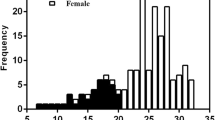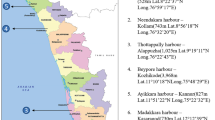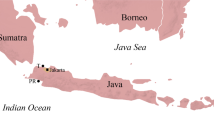Abstract
Cymothoid isopods (Crustacea, Isopoda) are considered as potential threat to the health of different fish species. In order to evaluate the prevalence and proximate analysis of Cymothoid isopods and its host, an investigation was carried out fish species belonging to families Hemiramphidae and Belonidae in the Palk Bay region, Southeastern India. A total of 1265 individuals of teleost fish belonging to family Hemiramphidae species, Hemiramphus far (462), H. archipelagicus (78), and H. lutkie (277) and another family Belonidae species, Tylosurus crocodilus (448), were examined for cymothoid ectoparasitic infestation. Prevalence in H. far was the highest (39%) for the cymothoid Mothocys plagulophora, while T. crocodilus was most infested (13%) with Mothocys renardi, H. far and H. lutkie were not infested by M. renardi while T. crocodilus was not infested by M. plagulophora. Proximate analysis showed reduced level of protein in parasite infested fish compared with non-infested individuals. However, carbohydrate and lipid concentrations were lower in infested fish than non-infested individuals. Proximate analysis values in the two parasites of Mothocys species were similar, and these values were comparable to those unaffected fish species indicating that parasites were well nourished. The proximate analysis of isopod parasite M. plagulophora showed 21.6 ± 7.7, 1.26 ± 0.05, 5.49 ± 1.06% of protein, carbohydrate and lipid respectively, and in M. renardi, 21.09 ± 6.6, 1.32 ± 0.12, 5.83 ± 0.72% of protein, carbohydrate and lipid respectively. Cadmium levels were similar between affected and non-affected fish individuals and among species. The Pb levels were comparable among all T. crocodilus individuals, but the levels of Cd not showed much variation between affected and unaffected individuals in all four fish species.

















Similar content being viewed by others
References
Agusa T, Kunitob T, Yasunaga G, Iwataa H, Subramanian A et al (2005) Concentrations of trace elements in marine fish and its risk assessment in Malaysia. Mar Pollut Bull 51:896–911
Barber I, Hoare D, Krause J (2000) Effects of parasites on fish behavior: a review and evolutionary perspective. Rev Fish Biol Fish 10:131–165
Barker DE, Cone DK, Burt MD (2005) Trichodina murmanica (Ciliophora) and Gyrodactylus pleuronecti (Monogenea) parasitinzing haychery-reared winter flounder, Pseudopleuronectes americanus (Walbaum): effects on host growth and assessment of parasite interaction. J Fish Dis 25:81–89
Bharadhirajan P, Murugan S, Sakthivel A, Selvakumar P (2014) Isopod parasites infection on commercial fish of Parangipettai waters, Southeast coast of India. Asian Pac J Trop Dis 4(1):S268–S272
Bruce NL (1986) Revision of the isopod crustacean genus Mothocya Costa, in Hope, 1851, (Cymothoidae: Flabellifera), parasitic on marine fish. J Nat Hist 20:1089–1192
Bunkley-Williams L, Williams EH Jr (1998) Isopods associated with fish: a synopsis and corrections. J Parasitol 84:893–896
Chavez-Lopez R, Rocha-Ramirez A, Alvarez F, Wetzer R (2005) Elthusa alvaradoensis Rocha-Ramirez, Chavez-Lopez & Bruce, 2005 (Isopoda; Cymothoidae) parasitizing the inshore lizard fish Synodus foetens (Linnaeus, 1766) on the continental shelf off central Vera Cruz, Mexico. Crustaceana 78:865–872
Dubois M, Gilles KA, Hamilton JK, Rebers PA, Smity F (1956) Colorimetric method for determination of sugars and related substances. Anal Chem 28:350–356
Dural Mettem, Ercument Gene M, Sangum Kemal, Gunei Ozlem (2011) Accumulation of some heavy metals in Hysterothylacium aduncum (Nematoda) and its host sea bream, Sparus aurata (Sparidae) from North–Eastern Mediterranean Sea (Iskenderun Bay). Environ Monit Asses 174:147–155
Fogelman R, Grutter AS (2008) Mancae of the parasitic isopod, Anilocra apogonae: early life history, host-specificity, and effect on growth and survival of preferred young cardinal fish. Coral Reefs 27(3):685–693
Folch J, Lees M, Stanley GHS (1957) A simple method for the isolation and purification of total lipid from animal tissues. J Biol Chem 226:497–509
Gopalakrishnan A, Rajkumar Sun Jun M, Trilles JP (2010) Occurrence of double parasitism on balck-barred halfbeak fish from the southeast coast of India. Chin J Oceanol Limnol 28(4):832–835
Haller G (1880) Über einige neue Cymothoinen. Archiv fur Naturgeschichte, Berlin, Jahrsbuch 46:375–395
Khandekar RN, Mishra UC, Vohra KG (1984) Environmental lead exposure of anurban Indian population. Sci Total Environ 40:269–278
Lester RJG, Roubal FR (2005) Isopod. In: Rohde K (ed) Marine parasitology. CSIRO Publishing, Collingwood, pp 138–144
Love RM (1970) The chemical biology of fish. Academic Press, London, pp 17–35
Lowry OH, Rosebrough NJ, Farr AL, Randall RJ (1951) Protein measurement with the Folin-Phenol reagents. J Biol Chem 193:265–275
Nair GS (1950) Two new species of Irona (Isopoda) parasitic on Madras fish. J Madras Univ 20B:66–74
Ozparlak Haluk, Arslan Gulsin, Arslan Emine (2012) Determination of some metal levels in muscle tissues of nine fish species from Beysehier Lake, Turkey. Turk J Fish Aquat Sci 12:761–770
Peakall D, Burger J (2003) Methodologies for assessing exposure to metals: speciation, bioavailability of metals & ecological host factors. Ecotoxicol Environ Saf 56:110–121
Poulin R (2007) Evolutionary ecology of parasites. Chapman and Hall, London
Radhakrishnan S, Nair NB (1983) Nature of crustacean infestation of fish along the south-west coast of India; distribution, mode of attachment to the host tissue and incidence and intensity of infestation. Acta Ichthyol Piscat 13(2):93–115
Raghunath R, Tripathi RM, Khandekar RN, Nambi KSV (1997) Retention times of Pb, Cd, Cu and Zn in children’s blood. Sci Total Environ 207:133–139
Rameshkumar G, Ramesh M, Ravichandran S, Trilles JP, Subbiah S (2014) Host-parasite relationships: Mothocya plagulophora parasitizing Hemiramphus far in the Southeast coast of India. J Parasit Dis. https://doi.org/10.1007/s12639-014-0438-2
Rameshkumkar G, Ravichandran S, Sivasubramanian K (2013) Invasion of parasitic isopods in marine fish. J Coast Life Med 1(2):88–94
Ravichandran S, Rameshkumar G, Trilles JP (2011) New records of two parasitic cymothoids from Indian fish. J Parasit Dis 35(2):232–234
Rhode K (ed) (2005) Marine parasitology. CSIRO Publishing and CABI Publishing, Victoria, p 592
Trilles JP (1994) Les Cymothoidae du Monde. Prodrome pour une Faune. Stud Mar 21/22:1–288
Wegner A, Boman J (2003) Biomonitoring of trace elements in muscle and liver tissues of freshwater fish. Spectrochim Acta Part B 58:2215–2226
Williams EH Jr, Bunkley-Williams L (1994) Four cases of unusual crustacean–fish associations and comments on parasitic processes. J Aquat Anim Health 6:202–208
Acknowledgements
Authors are thankful to authorities of Bharathidasan University for the facilities provided and also grateful to Dr. S. Ravichandran, Centre of Advanced Study in Marine Biology, Annamalai University, Parangipettai, India for identification of parasitic isopod species.
Author information
Authors and Affiliations
Contributions
Conceived and designed the experiments: RR, SV. Performed the experiments: RR, RK and SV. Analyzed the data and wrote the paper: RR and EPM.
Corresponding author
Ethics declarations
Conflict of interest
All the authors declare that there is no conflict of interest regarding publication of the articles.
Ethical statements
The four species of marine food fishes viz. Hemiramphus far, H. archipelagicus, H. lutkie and Tylosurus crocodilus belonging to families Hemiramphidae and Belonidae are not governed by any law. Therefore, the organisms were not placed for Institutional Animal Ethical Committee (IAEC) approval. All the experiments were performed for best practice according to Bharathidasan University IAEC guidelines. Furthermore, we did not conduct any experimentation with human subjects.
Rights and permissions
About this article
Cite this article
Rajaram, R., Rakesh Kumar, K., Vinothkumar, S. et al. Prevalence of cymothoid isopods (Crustacea, Isopoda) and proximate analysis of parasites and their host fishes, Southeastern India. J Parasit Dis 42, 259–268 (2018). https://doi.org/10.1007/s12639-018-0995-x
Received:
Accepted:
Published:
Issue Date:
DOI: https://doi.org/10.1007/s12639-018-0995-x




